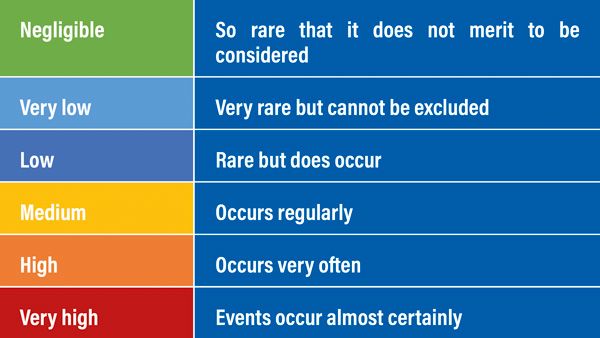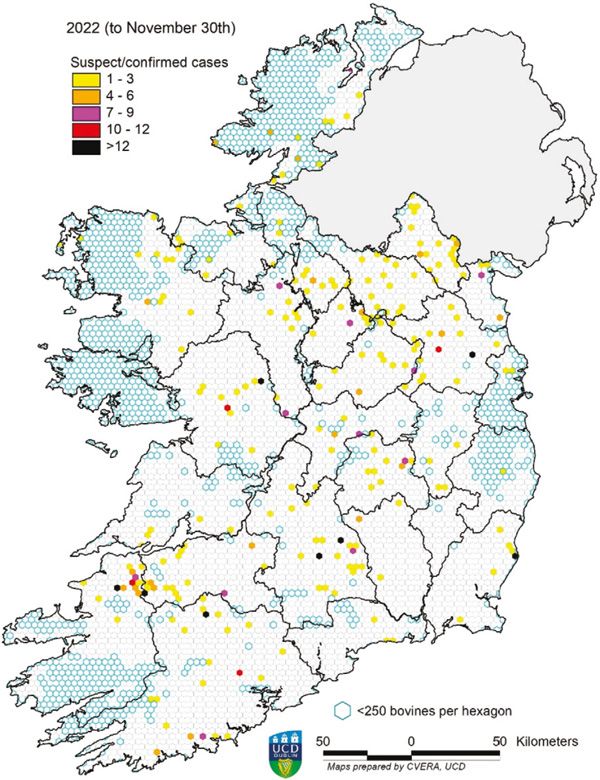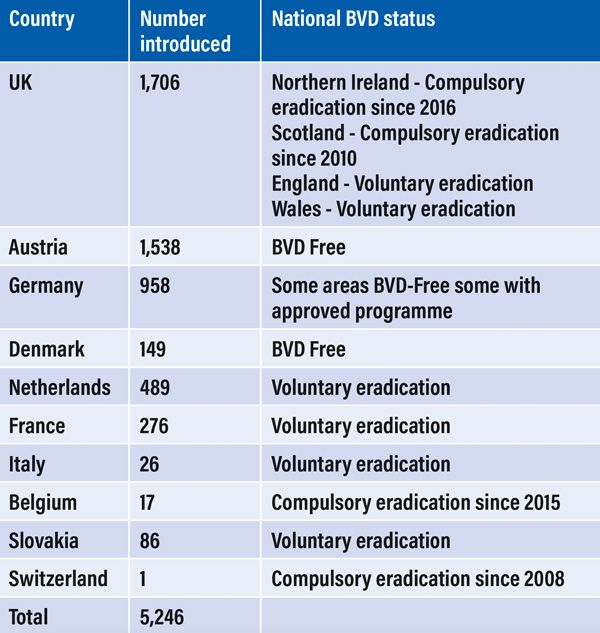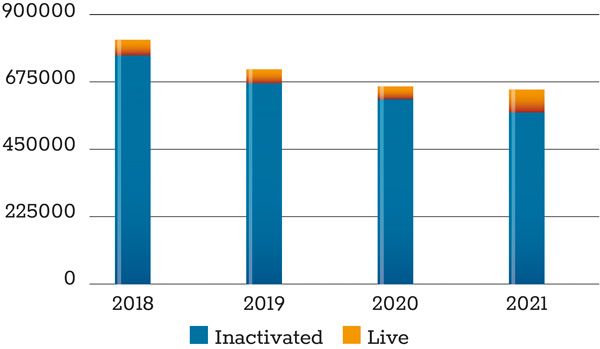Assessing the risk of re-emergence of BVD
Damien Barrett MVB MVM MSc PhD Cert CHP Dip ECBHM, Department of Agriculture, Food and the Marine and Maria Guelbenzu LV PhD MRCVS, BVD Programme Manager, AHI, explore qualitative assessment on the re-emergence of BVD following national BVD freedom
The Irish BVD eradication programme, which has been compulsory since 2013, has made substantial progress on the reduction of prevalence of BVD, both at animal and herd level (for the latest programme results: www.animalhealthireland.ie). A series of enhancements to the programme were introduced by the BVD Implementation Group in 2021 in order to progress to eradication and to align the programme with the new EU Animal Health Law (AHL). The AHL sets out the requirements for approval of BVD programmes and BVD-freedom at EU level for the first time. An application for approval of the Irish BVD programme was submitted in 2022 and the programme was officially approved on July 18 2022. This approval is a key milestone for the programme and a prerequisite for applying for recognition for freedom.
The conditions for BVD freedom under the AHL include a ban on vaccination, not having had a confirmed case in the previous 18 months and having BVD-free status for 99.8% of all herds representing at least 99.9% of cattle. When BVD freedom is achieved, it is envisaged that individual tissue tag testing of calves will be phased out and there will be a move toward serological surveillance which will assign a herd status based on sampling a subset of the herd, either by milk or serum. This surveillance is likely to lead to a lag in the time to the identification of any persistently infected animals (PIs) compared to the individual testing of all calves. At this point it will also be key to assess the risk of re-emergence of the disease so that policies can be put in place to minimize those risks.
Therefore, the key question is ‘what is the risk of the re-emergence of BVD in Ireland once BVD freedom has been achieved?’ For the purpose of this risk assessment, EFSA-derived definitions have been used as in Table 1 and risks have been evaluated for the year 2023.

Table 1: EFSA definitions of risk.
Probability of introduction of BVD
The first step is to identify the different biological pathways that could facilitate re-emergence of the virus and then to assess the probability of disease re-emergence under each of these pathways. A large body of research has been carried out on the Irish BVD eradication programme which has been used to inform the development of the programme. Several studies have explored risk factors associated with BVD outbreaks, the impact of retention of PI calves, trojans, etc and these have been used as a source of information to develop the following list of pathways.
1. Non detected BVD residual infection giving rise to infections in previously free herds
While there has been considerable progress in the eradication of BVD, approximately one third to half of outbreaks have occurred in herds with no prior history of BVD infection. In 2019, this accounted for 202 of the 573 (35 per cent) test positive herds, 153 of the 406 test positive herds in 2020 (39 per cent), 157 of the 348 test positive herds in 2021 (45 per cent) and 148 of the 283 test positive herds in 2022 to date (52 per cent). An analysis of herds with no previous history where BVD emerged in 2019 for the first time concluded increasing herd size, the purchase of trojan dams and geographical proximity to an infected herd were all significant factors in the emergence of BVD (Casey-Bryars et al., 2022).
A suite of enhanced measures to accelerate the eradication of BVD were put in place in 2021 and are to continue into 2023. These include immediate herd restrictions, a whole herd test for antigen/virus, not moving potential trojan cows, and the vaccination of breeding females. While these enhanced measures are anticipated to reduce the prevalence of BVD markedly, a residual undetected infection cannot be ruled out and post eradication serological surveillance is not likely to detect such infection as efficiently as tissue tag testing. The likely number of such herds in 2023, is however, expected to be a further reduction on the number seen in 2022.
Risk – low
2. Trojan births
Pregnant animals that have suffered a transient infection and are carrying a PI foetus in one herd and which are then introduced to another herd are called ‘Trojan cows’. Internationally several studies have emphasised the importance of Trojan cows in the re-emergence of BVD. Over the years the relative importance of Trojan births has increased in the Irish programme, increasing from 7.8 per cent in 2013 up to 20.3 percent in 2021, notwithstanding falling national animal and herd-level prevalence. This has been repeatedly identified as significant risk factors and most recently in a study of epidemiological drivers of BVD in a low prevalence system (Graham et al., 2013; Reardon et al., 2018; Barrett et al., 2020; Casey-Bryars et al., 2022). Since 2021, herds with positive results are required to retain on their holding any females that were in calf at the time of disclosure of the positive result until its calf is born and BVD tested. Again, the likely number of Trojan births in 2023 will be correlated to the epidemiological situation in 2022.
Risk – medium
3. Proximity effect
Proximity to an infected herd has been shown to be associated with a herd becoming positive in the following year (Barrett et al., 2020; Casey-Bryars et al., 2022). Transmission may occur by direct contact from an infected animal through nose to nose spread across a boundary or between herds through a person or fomite. In either case, this will lead to a biosecurity breach. Therefore, herds in the vicinity of test positive herds in 2022 (Figure 1) are at an increased risk from local spread. The relative importance of this risk factor in 2023 will be proportional to the epidemiological situation in 2022.
Risk – low

Figure 1: map showing distribution of births of BVD test+ calves during 2022 until November 30. Each hexagon represents an area of approximately 10 sq. kms. Herds located within hexagons with suspect cases in 2022, or adjacent to them, are at greater risk of having suspect cases in 2023 due to this proximity effect.
4. History of infection
In a study of herds which had lost their BVD negative herd status for BVD in 2017, it was found that herds with a history of BVD were 23 times more likely to have subsequent positive results than those herds with no previous history of infection (Barrett et al., 2020). Therefore, herds with a history of BVD are more likely to experience a re-emergence event post eradication but the study could not determine if this was due to residual infection within the herd or if there were management practices conducive to the introduction of BVD. From 2021, this risk is addressed through the enhanced measures applied in positive herds, which include the vaccination of the breeding herd for two consecutive years. Again, the relative importance of this risk factor will be proportional to the epidemiological situation in 2022.
Risk –low
5. Role of transient infection from infected herds
An exploratory analysis of herd becoming test positive for BVD in 2021 found 20% of those herds had purchased cattle from herds which had been positive in 2020, suggesting a possible role for transient infections spreading infection in such herds (Graham, personal communication). Since 2021, test positive herds undergo whole herd blood testing and the herds have remain restricted until no animals are test positive. While this dramatically reduces the potential for onward spread to other herds, it does not completely eliminate it. Again, the relative importance of this risk factor in 2023 will be proportional to the epidemiological situation in 2022.
Risk – low
6. Purchase of persistently infected cattle
All cattle born since 2013 have required a BVD test negative status to be allowed to move from farm to farm, and this was extended to all cattle in 2020. However, this requirement is likely to be removed when BVD freedom is achieved, and herds will, over time, be assigned a trade status based on a serological screening and allowed to trade until such time as the screen proves positive. In 2019, there were approximately 2.97 million cattle movements recorded in Ireland. Of these, 1.3 million were direct farm to farm movements, while the remaining 1.67 million movements went through a cattle mart (Anon, 2020).
Risk – negligible (currently)
Risk - very low (for cattle born after the achievement of eradication)
7. Infection from sheep
Although the natural host of BVDV is cattle, it can infect other domestic and wild ruminants such as sheep, deer and pigs. Border disease virus of sheep can also be detected in pigs and occasionally, cattle. Some studies have implicated pestivirus infection in sheep as a potential source of infection for cattle and have highlighted the risk that such infection may pose in achieving eradication in the first instance and re-introducing BVD in the event of eradication being achieved.
There are 3.7 million sheep in 35,186 Irish sheep flocks across the country. In 2019, DAFM carried out a survey of 2,059 lambs, in 196 flocks, revealing an animal level prevalence of 0.194 per cent and a flock prevalence of 2.04 per cent. Previous studies revealed animal level prevalence of 5.3 per cent (Graham et al., 2001) and 5.8 per cent (O’Neill et al., 2004). This reduction in the prevalence may be related to the reduced circulation of BVD virus as opposed to Border disease and suggests a decreasing risk for cattle.
Risk – negligible
8. Infection from wildlife
Similar to sheep, there have been concerns that there may a reservoir of pestivirus infection in the deer population in Ireland. There are no accurate estimates on the deer population, but surveys have indicated up to a five-fold expansion in red deer numbers in Ireland between the 1970s and 2010. A survey of 390 deer in 2017 found four BVD seropositive out of the 390 (1.5 per cent) deer sampled giving a true prevalence of 0 per cent (Graham et al., 2017). The results indicate a very low seroprevalence for BVDV in the wild deer tested within the study and, are consistent with a very low prevalence in Ireland.
Risk – negligible
9. Importation/introduction of an animal infected with BVD
In general, there are low number of animals being introduced from other EU countries or imported from outside the EU into Ireland for breeding (Table 2). Introduced animals are routinely sampled and tested, both for virus and antibody, to detect any potential trojan cows. In 2021, there were 8,502 introduced animals in total tested for BVD and all were negative. As Ireland’s BVD eradication programme is now approved by the EU Commission, it provides further protection as all introduced cattle must either come from a BVD free establishment or be tested free of BVD.
Risk – very low.
10. Importation or Introduction of embryos and semen
While there may be a theoretical risk these products may transmit BVD, there are onerous testing protocols in place to ensure semen is not collected from bulls infected with BVD, and these must be adhered to if the semen is to be eligible for international trade. Similar testing arrangements are in place for embryo production and embryos undergo a process called washing to ensure they are not harbouring BVD.
Risk - negligible

Table 2: cattle introductions for further breeding and production by country of origin and national BVD status in 2021.
11. Vaccination
The contamination of a bovine herpesvirus 1 marker vaccine with BVD virus type 2 led to BVD outbreaks on several farms in the Netherlands in 1999 (Barkema et al., 2001). These outbreaks led to anxiety about the use of live BVD vaccines. However, this is not likely to be a significant issue as the bulk of the BVD vaccines sold on the Irish market are inactivated. In addition, the single modified live vaccine currently on the market has a double gene deletion which make a harmful mutation very unlikely. Overall, the use of vaccine has reduced over the last few years (Figure 2). Furthermore, once Ireland achieves BVD freedom, the use of BVD vaccination will be prohibited.
Risk - negligible

Figure 2: number of BVD vaccine doses sold in Ireland per year and vaccine type.
12. Northern Ireland
There are approximately 1.7 million cattle in NI residing in around 22,000 cattle herds. A BVD programme based on tissue tag testing of calves has been compulsory since 2016. The annual animal incidence of BVD fell from 0.68 per cent in 2016 to 0.29 per cent in 2020 (Strain et al., 2021). In the same period, the annual herd incidence fell from 11.3 per cent in 2016 to 5 per cent. It is notable that the starting incidences for both programmes were remarkably similar. While the infection is distributed across Northern Ireland, the infection intensity in border regions is among the highest.
There are close family, cultural and commercial relationships between farmers on both sides of the border. There is substantial cross border trade in animals and several businesses in border areas service clients in both jurisdictions, including those that come in direct contact with cattle, like veterinary practitioners, hoof parers and artificial insemination technicians. A Danish risk assessment of the risk of the introduction of BVD attributed increased risk to hoof trimmers and veterinary practitioners who practiced in countries which were not BVD free and visited herds in Denmark (Foddai et al., 2014). A recent study on the seroprevalence in the Irish cattle population found counties bordering Northern Ireland as having the highest risk of BVDV exposure (Barrett et al., 2022).
Risk – low to medium
Conclusions
In conclusion, the overall risk of re-emergence of BVD is considered to be very low, based on the analysis above. However, there may be variation based on previous BVD history and proximity and epidemiological links to previous outbreaks.
References
Available on request
1. REGARDING Trojan animals – WHICH OF THE FOLLOWING IS TRUE?
A. Some studies have highlighted the importance of Trojan cows in the re-emergence of BVD
b. Since 2021, herds with positive results are not to sell any females that were in calf at the time of disclosure of the positive result until its calf is born and BVD tested
c. Over the years the relative importance of Trojan births has increased in the Irish programme
d. All of the above
2. Regarding sheep – WHICH OF THE FOLLOWING IS TRUE?
A. Sheep may be affected by both BVDV and Border disease virus
b. The exposure of sheep to pestiviruses in Ireland seem to have decreased over the last years
c. The risk posed by sheep for the reintroduction of BVD to cattle was found to be negligible
d. All of the above
3. The risk factors for herds with no previous history where BVD emerged in 2019 for the first time were:
A. Increasing herd size, sharing equipment and neighbouring a positive herd
b. Increasing herd size, the purchase of trojan dams and geographical proximity to an infected herd
c. Herd size, animal movements and sharing equipment
d. Herd size, purchasing trojan dams and neighbouring a positive herd
4. Which statement is not true:
A. Herds with a history of BVD are more likely to experience a re-emergence event
b. Proximity to an infected herd has been shown to be associated with a herd becoming positive in the following year
c. Herds will be able to continue vaccinating for BVD after obtaining EU-recognised freedom
d. Although deer may be infected with BVD, studies have shown very low prevalence of exposure to BVD in deer in Ireland.
Answers: 1D; 2D; 3B; 4C.









